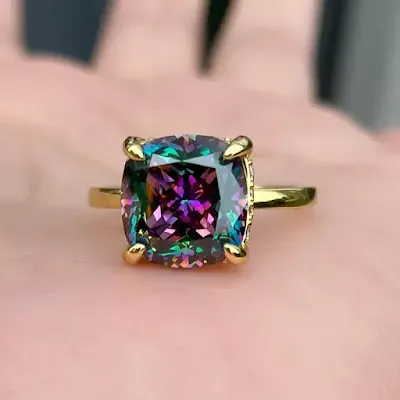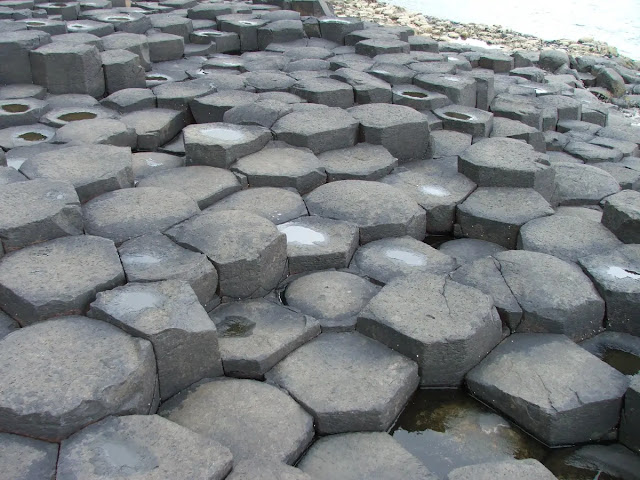Alexandrite: Rare Color-Changing Gemstone
Alexandrite is a rare and beautiful gemstone known for its stunning color change. It appears emerald green in daylight and reddish-purple under incandescent light. This dramatic shift in color is called the alexandrite effect.
Alexandrite is a variety of the mineral chrysoberyl. It was first discovered in the Ural Mountains of Russia in the 1830s and named after Tsar Alexander II. Alexandrite is now found in a number of other locations, including Sri Lanka, East Africa, and Brazil.
Due to its rarity and unique color-changing properties, alexandrite is a valuable gemstone. It is often used in jewelry, such as rings, necklaces, and earrings. Alexandrite is also the birthstone for June and the gemstone for the 55th wedding anniversary.
 |
| Alexandrite: Properties, color, Rarity, Price |
Alexandrite Properties
Alexandrite boasts a unique combination of physical and optical properties that contribute to its beauty and value. Here's a breakdown of its key characteristics:
Composition: Alexandrite is a variety of the mineral chrysoberyl, belonging to the beryllium aluminate silicate family with the chemical formula BeAl₂O₄ (beryllium aluminum oxide).
Physical Properties
- Color: Alexandrite's most famous property is its color change. It exhibits pleochroism, appearing emerald green in daylight or fluorescent light and reddish-purple under incandescent light.
- Transparency: Alexandrite can be transparent to translucent, allowing light to pass through completely or partially.
- Luster: Alexandrite has a vitreous luster, resembling the glassy shine of high-quality glass.
- Crystal System: Alexandrite crystals belong to the trigonal crystal system, characterized by a three-fold rotational symmetry axis.
- Streak: Streak refers to the color of a mineral powder. Alexandrite's streak is white.
- Hardness: Alexandrite ranks 8.5 on the Mohs scale of mineral hardness, making it quite durable and suitable for jewelry applications.
- Cleavage: Alexandrite exhibits imperfect parting or cleavage along specific crystallographic directions.
- Fracture: Alexandrite has a conchoidal fracture, meaning it breaks with smooth, curved surfaces resembling a seashell.
- Habits and Forms: Alexandrite crystals typically occur in short, prismatic forms or rounded grains. Some Alexandrite crystals can exhibit a phenomenon called twinning.
- Density (Specific Gravity): Alexandrite has a specific gravity of around 3.7 – 3.8, which means it's denser than most common rocks but lighter than many metals.
- Tenacity: Tenacity describes a mineral's resistance to breakage. Alexandrite is considered brittle, meaning it can shatter or chip with a forceful blow.
- Solubility: Alexandrite is insoluble in water and most common acids.
- Magnetism: Alexandrite is not magnetic.
Optical Properties
- Fluorescence: Alexandrite can exhibit weak fluorescence under ultraviolet light, sometimes appearing faintly reddish or yellowish.
- Pleochroism: As mentioned earlier, alexandrite exhibits strong pleochroism, causing its color to change depending on the viewing direction and light source.
- Refractive Index: The refractive index of alexandrite ranges from 1.746 to 1.755, which is relatively high and contributes to its brilliance.
Additional Properties
- Inclusions: Alexandrite can sometimes contain inclusions, which are foreign materials trapped within the gemstone during its formation. These inclusions can affect the stone's value and appearance.
 |
| Rough (raw) Alexandrite crystal. left side is under daylight spectrum, right under light bulb. Photo: Martin Slama |
Why does Alexandrite change color?
Alexandrite appears green in natural light (daylight) and red or purplish-red in incandescent light (artificial light). The color-changing magic of Alexandrite is all about how it interacts with light! Here's the science behind it:
Trace Amounts of Chromium: The key player is the presence of chromium (Cr) within the crystal structure of Alexandrite. This same element is responsible for the red color in rubies and the green color in emeralds.
Selective Absorption: Alexandrite absorbs certain wavelengths of light more than others. Chromium specifically absorbs light in the yellow and blue parts of the visible light spectrum.
Light Source Matters: Sunlight and incandescent light have different compositions. Sunlight is rich in blue and green wavelengths, while incandescent light has more red and yellow wavelengths.
Green in Daylight: When exposed to daylight, the yellow and blue are absorbed by the chromium, leaving the green and red wavelengths to be transmitted or reflected. Our eyes perceive these remaining colors as green, giving Alexandrite its characteristic emerald green hue.
Red under Incandescent Light: Under incandescent light, the situation flips. The remaining red and some orange wavelengths, which weren't absorbed earlier, dominate the light reaching our eyes, causing the Alexandrite to appear reddish-purple.
Human Perception Plays a Role: It's important to note that some scientific theories suggest our own visual system might also contribute to the perceived color change. However, the primary factor is definitely how Alexandrite absorbs and transmits different light wavelengths.
Overall, the interplay between chromium's absorption and the light source's composition creates the dramatic color change that makes Alexandrite so unique and captivating.
 |
| Rough alexandrite twin crystals Izumrudnye Kopi area, Malyshevo, Sverdlovsk Oblast, Russia Photo: Manfred Kampf |
Where alexandrite is found?
Alexandrite, a rare and beautiful gemstone, can be found in a few scattered locations around the globe. Here's a quick recap:
Origin Story: Russia (Ural Mountains)
The first discovery of Alexandrite dates back to the 1830s in Russia's Ural Mountains. These mines produced exceptional stones with a vivid color change, but they are now largely depleted.
Modern Sources:
Sri Lanka: A significant source today, offering good color change but often less intense than historical Russian stones.
East Africa (Tanzania, Madagascar): Deposits have been found in these countries. The color change in these stones can vary, with some displaying a desirable shift and others being less pronounced.
Brazil: Discovered in the late 1980s, Brazilian Alexandrite can be colorful but might not be as rare or vibrant as stones from other sources.
Trace Amounts: India, Burma (Myanmar), and Zimbabwe have minor deposits, but their contribution to the market is minimal.
Alexandrite Rarity
Alexandrite is considered one of the rarest gemstones on Earth, and its rarity contributes significantly to its value. Here's why Alexandrite is so uncommon:
Specific Geological Conditions: The formation of Alexandrite requires a unique combination of elements and geological processes. Beryllium (Be) is a key component, but it's a relatively rare element itself. Additionally, chromium (Cr), responsible for the color change, needs to be present in trace amounts alongside beryllium for Alexandrite to form. These elements rarely co-exist in the ideal concentrations and geological environments necessary for Alexandrite to crystallize.
Color Change Impact: Not all chrysoberyl varieties exhibit the dramatic color change that defines Alexandrite. Stones with a weak or undesirable color shift are less valuable and contribute less to the market availability of true Alexandrite.
Due to its scarcity and unique optical properties, alexandrite is considered one of the most valuable and sought-after gemstones. Its rarity, coupled with its captivating color-changing effect, makes it highly prized among collectors and connoisseurs of fine gemstones.
 |
| Alexandrite ring |
Alexandrite Value and Price
Alexandrite is a valuable gemstone, and its price can vary significantly depending on several factors. Here's a breakdown of what influences the cost:
Color Change: The strength and desirability of the color change are paramount. A vibrant emerald green in daylight shifting to a rich reddish-purple under incandescent light commands the highest prices.
Size: Larger alexandrites are naturally rarer and more expensive. Carat weight significantly impacts the price, with larger stones (above 1 carat) reaching much higher per-carat costs.
Clarity: The presence of inclusions or flaws can affect transparency and brilliance, reducing the value. Cleaner stones with minimal inclusions are more valuable.
Cut: A well-cut alexandrite maximizes its color change and brilliance. The cut should optimize light reflection and showcase the stone's beauty.
Origin: While alexandrite is found in various locations, some sources are more prized. Traditionally, Russian alexandrite has held a higher value due to its historical significance and vibrant color change.
Price: Here's a general price range to give you an idea:
Under 1 carat: For smaller stones, prices can range from $5,000 to $15,000 per carat, depending on quality.
Over 1 carat: Larger stones can reach much higher price points, with some exceeding $50,000 or even $70,000 per carat for exceptional quality.
 |
| Rough alexandrite in different light. |
Is alexandrite more expensive than diamonds?
Generally, yes, alexandrite is more expensive than diamonds, especially when considering similar sizes and qualities. Here's a breakdown:
Rarity: Alexandrite is significantly rarer than diamonds. While diamond deposits are more widespread, the specific conditions needed for alexandrite formation are uncommon.
It's important to note that some exceptionally rare diamonds, like vivid colored ones, can surpass the price of alexandrite.
 |
| Alexandrite ring |
Alexandrite FAQ
Can alexandrite be treated or enhanced?
While some gemstones undergo treatments to enhance their color or clarity, natural alexandrite is generally not treated. However, synthetic alexandrite, which is created in laboratories, may undergo treatments to improve its appearance.
Is natural alexandrite better than synthetic alexandrite?
Both natural and synthetic alexandrite can be beautiful gemstones. Natural alexandrite is rarer and may hold more value, but synthetics can be a more affordable option. Ultimately, the choice depends on your preferences and budget.
Is Alexandrite a birthstone?
Yes, Alexandrite is the birthstone for June, along with pearl. It is also the gemstone for the 55th wedding anniversary.
Alexandrite lore and legend?
Alexandrite is associated with creativity, prosperity, and good luck. Some believe it can enhance intuition and bring positive change.
Conclusion
In conclusion, Alexandrite is a fascinating gemstone valued for its unique color-changing properties, rarity, and brilliance. Its price reflects these qualities, making it a coveted gemstone for collectors and jewelry enthusiasts.



%20(1).webp)




